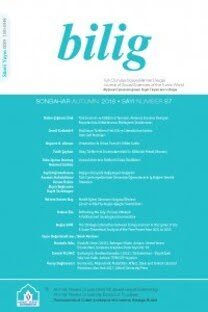Türk İmalat Sanayiinde İllere Göre Yerelleşme ve Kentleşme Ekonomilerinin Belirlenmesi
Yığılma ekonomileri, ekonomik faaliyetlerin belirli bir mekanda toplanması sonucu maliyetlerde gerçekleşen azalmayı ifade etmektedir. Yığılma ekonomilerinin farklı etkinlikte ve büyüklükte olmaları nedeniyle yığılma sürecinde gerçekleşen coğrafi örüntü farklılık arz etmekte, böylece ekonomik birimlerin yerleşimi de eş dağılım göstermemektedir. Bu nedenle, mekansal yığılmaya yol açan faktörlerin belirlenmesi büyük önem taşımaktadır. Yığılma ekonomileri, literatürde durağan (statik) ve dinamik dışsallıklar bağlamında ele alınmaktadır. Çalışmanın temel amacı, Türkiye’de imalat sanayinde illere göre durağan dışsallıklar bağlamında yığılmaların belirlenmesidir. Bu amaçla, üretim fonksiyonu yaklaşımı kullanılarak her ilin iktisadi coğrafya örüntüsünü belirleyen durağan yığılma ekonomileri olan yerelleşme ve kentleşme ekonomilerinin tahminine yönelik ampirik bir çalışma ortaya koyulmuştur. 1985-2000 döneminde illerin imalat sanayilerinin Uluslararası Sanayi Sınıflaması (ISIC) Revize 2’ye göre düzenlenmiş panel veri seti kullanılmış, dinamik panel veri tahmin teknikleri uygulanmıştır.
Anahtar Kelimeler:
Türkiye
Identifying the Localization and Urbanization Economies by Provinces in Turkish Manufacturing Industry
Agglomeration economies suggest a decrease in costs as a result of the accumulation of economic activities in a certain region. Because agglomeration economies differ in terms of both size and activity, the geographical patterns that emerge during the agglomeration process also exhibit significant differences, which in turn hinders the equal distribution of economic units in the region. That is why it is very important to determine the factors that lead to regional agglomeration. In the literature agglomeration economies are discussed within the context of static and dynamic externalities. The major aim of this study is to identify the agglomerations in Turkish manufacturing industry by provinces within the context of static externalities. For this purpose this study adopts an empirical perspective and makes use of the production function approach in order to predict the growth of localization and urbanization economies, which are the static agglomeration economies determining the economic-geographical pattern of each province. The study uses a panel data set showing the state of the manufacturing industries of each province between the years 1985-2000 arranged according to the International Standard Industry Classification (ISIC), 2nd Revision. The study also applies dynamic panel data prediction techniques.
Keywords:
Turkey,
___
BALTAGI, Badi H (2001), Econometric Analysis of Panel Data, Jhon Wiley & Sons, Second Ed.DOĞAN, Ergun (2001), “External Scale Economics in Turkish Manufacturing Indsutries”, International Review of Applied Economics, 15.
FİLİZTEKİN, Alpay (2002), “Agglomeration and Growth in Turkey, 1980-1995”, Sabanci Univ. Discussion Paper Series in Economics Suecdp.02.01, January.
FUJITA, M. ve J.F. THISSE (2000), “The Formation of Economic Agglomerations: Old Problems and New Perspectives”, J.M. HURIOT ve J.F THISSE (Ed), Economics Of Cities, Cambridge University Press,: 3-73.
FUJITA, Masahisa (1989), Urban Economic Theory: Land Use and City Size, Cambridge Univ. Pres.
GLAESER, E.L., H.D. KALLAL, J.A. SCHEINKMAN ve A. SHLEIFER (1992), “Growth in Cities”, Journal of Political Economy, 61: 1126-1152.
GOLDSTEIN, G.S. ve T.J. GRONBERG (1984), “Economies of Scope and Economies of Agglomeration”, Journal of Urban Economics, 1691-104.
HANSON, G.H. (2000), “Scale Economies and the Geographic Concentration of Industry”, NBER Working Paper Series, Working Paper No: 8013.
HSAIO, C. (2003), Analysis of Panel Data, Cambridge University Press.
HENDERSON, J.Vernon (1974), “The Sizes and Types of Cities”, American Economic Review, 64: 640-656.
HENDERSON, V., A. KUNCORO ve M. TURNER (1995), “Industrial Development in Cities”, Journal of Political Economy, vl.103, no.5: 1067-1190.
KIYMALIOĞLU, Ümit (2004), “Yığılma Ekonomileri”, DPT-PAÜ Kentsel Ekonomik Araştırmalar Sempozyumu, Cilt-1: 364-384.
KIYMALIOĞLU, Ümit (2005), “Dışallıklar, Yığılma Ekonomileri, Türkiye’de İllere Göre Yığılmaların Belirlenmesi”, Yayınlanmamış Doktora Tezi, Hacettepe Üniv. Sos. Bil. Enstitüsü
KÜÇÜKER, Celal (1998), “Kentsel Büyüme Dinamikleri”, C.KÜÇÜKER (Ed.), Anadolu’da Hızla Sanayileşen Kentler: Denizli Örneği, Türk Ekonomi Kurumu: 40-82.
KÜÇÜKER, Celal (2000), “ Yeni Ekonomik Cotrafya ve Kalkınma”, Ekonomik Yaklaşım, 38.
KRUGMAN, Paul (1996), Development, Geography, and Economic Theory, The MIT Press.
LUCIO, J.J., J.A. HERCE ve A. GOICOLEA (2002), “The Effects of Externalities on Productivity Growth in Spanish Industry”, Regional Science and Urban Economics, 32, 2002: 241-258.
MANO, Y. ve K. OTSUKA (2000), “Agglomeration Economies and Geographical Concentration of Industries: A Case Study of Manufacturing Sectors in Postwar Japan”, Journal of the Japanese and International Economies, 14: 189-203.
MARSHALL, Alfred. Principles of Economics, 8th ed., Macmillan, 1920.
McCANN, Phillip (1995), “Rethinking the Economics of Location and Agglomeration”, Urban Studies, 32: 563-578.
McCANN, Phillip (2001), Urban and Regional Economics, New York: York Oxford Univ. Pres.
McDONALD, John F. (1997), Fundamentals of Urban Economics. NJ: Pretince-Hall.
MUKKALA, Kırsı (2004), “Agglomeration Economies in the Finish Manufacturin Sector”, Applied Economics, 36: 2419-2427.
NAKAMURA, R. (1985), “ Agglomeration Economics in Urban Manufacturing Industries: A Case of Japanese Cities”, Journal of Urban Economics, 17: 108-124
SULLIVAN, Arthur (2003), Urban Economics, 4.Ed, Irwin, McGraw-Hill.
TABUCHI, T. (1986), “Urban Agglomeration, Capital Augmenting Technology, and Labor Market Equilibrium”, Journal of Urban Economics, 20: 211-228.
TABUCHI, T. (1998), “Urban Agglomeration and Dispersion: A Synthesis of Alanso and Krugman” Journal of Urban Economics, 44: 333-351.
WOOLDRIGE, Jeffery M. (2003), Econometric Analysis of Cross Section and Panel Data. The MIT Press.
- ISSN: 1301-0549
- Yayın Aralığı: Yılda 4 Sayı
- Başlangıç: 1996
- Yayıncı: Ahmet Yesevi Üniversitesi Mütevelli Heyet Başkanlığı
Sayıdaki Diğer Makaleler
Tatar Türklerinde Mitolojik Varlıklarla İlgili Mitler ve İnanışlar (İyeler ve Yaratıklar)
Fahriyeler Işığında Osmanlı Şiirinde İdeal Şairin Portresi
MURAT DEMİRBAŞ, RAHMİ YAĞBASAN
Çankırı Fatihi Karatekin'in Türbesi
Metatez Olayı Türkçenin Hece Sistemiyle İlgili midir?
Eğiticinin Performansını Niteleyen Faktörler
Sibirya Türklerinde Ateşle İlgili İnançlar, Törenler ve Bazı Efsaneler
